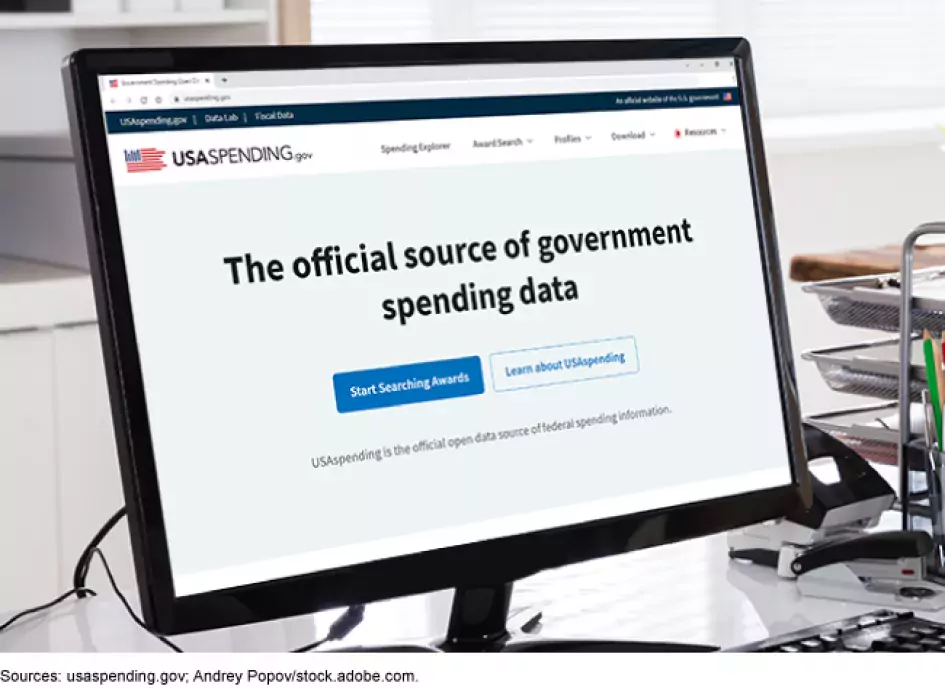Federal Spending Data Quality—Is This As Good As It Gets? Auditors Say It Can Be Better
Federal agencies spent $10.1 trillion in fiscal year 2021. But $131.8 billion of that was not reported, according to USAspending.gov—the official source of government spending data. Additionally, it was not always clear how the total $10.1 trillion was spent or if the data displayed is accurate.
The DATA Act—which Congress passed in 2014—requires agencies to publicly report high-quality spending data on USAspending.gov to create transparency in government spending. But 8 years later, audits by offices of inspector general (OIG) are still saying that agencies could do better.
Today’s WatchBlog post explores the results from our review of the 57 OIG reports to help Congress, journalists, and the general public identify which spending data they can rely on.
Image

Certain spending data is less reliable
Some of the worst quality spending data on the website include information on recipients and on when and where contracts and grants took place, which are supposed to provide transparency as to where taxpayers’ dollars went. We also found that more than 6 out of every 10 agencies had errors with dollar value-related data—such as the values of contract awards—which are key to tracking how much money federal agencies spent.
Agencies were ultimately responsible for some of these issues, but some of these errors were beyond the agencies’ control and caused by external third-party systems. For example, some contract amounts were inaccurate because of the way that the amounts are derived from the federal procurement data system.
Some OIGs reported their agencies only had moderate or lower quality data
While most of the 57 agencies’ data were of higher or excellent quality, 8 agencies’ overall data quality levels were deemed “moderate” (meaning only some errors) and 4 were lower quality, according to their OIGs. That means some spending data for agencies, such as the Departments of Agriculture, Homeland Security, Labor, and the Federal Communications Commission were not very reliable.
Additionally, 31 agencies had issues with the quality of their COVID-19 spending data, according to their OIGs. For example, the Departments of Defense and Homeland Security, as well as Veterans Affairs and the U.S. Army Corps of Engineers had incomplete, inaccurate, and untimely COVID-19 data. This means that we may never know how agencies spent portions of the trillions of dollars in COVID-19 funding.
While OIG oversight is important, it could end soon
Forty-four of the 57 agencies received recommendations from OIGs that would improve their spending data quality. These included actions such as agencies implementing processes to review data validation errors prior to submitting data to USAspending.gov and controls over data from award systems. Some OIGs also recommended that agencies report system errors to Treasury to ensure that information from external systems is correctly reported.
Although OIGs’ recommendations have and can in the future help improve the quality of information available to the public and Congress, the requirement for OIGs to review and report on data quality has ended. Because of this, we asked Congress to consider extending that requirement.
To learn more, check out our full reports on federal data transparency.
- Comments on GAO’s WatchBlog? Contact blog@gao.gov.
GAO Contacts
Related Products

GAO's mission is to provide Congress with fact-based, nonpartisan information that can help improve federal government performance and ensure accountability for the benefit of the American people. GAO launched its WatchBlog in January, 2014, as part of its continuing effort to reach its audiences—Congress and the American people—where they are currently looking for information.
The blog format allows GAO to provide a little more context about its work than it can offer on its other social media platforms. Posts will tie GAO work to current events and the news; show how GAO’s work is affecting agencies or legislation; highlight reports, testimonies, and issue areas where GAO does work; and provide information about GAO itself, among other things.
Please send any feedback on GAO's WatchBlog to blog@gao.gov.




